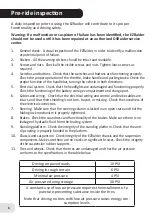
6
A daily inspection prior to using the EZRaider will contribute to its proper
functionality and driving safety.
Warning: If a malfunction or suspicion of failure has been identified, the EZRaider
should not be used until it has been repaired at an authorized DSRaider service
center.
1. General check. A visual inspection of the EZRaider, in order to identify a malfunction
or potential point of failure.
2. Stickers. All the warning stickers should be intact and readable.
3. Screws and nuts. Check all the visible screws and nuts. Tighten loose screws as
required.
4. Switches and buttons. Check that the switches and buttons are functioning properly.
Check the proper operation of the throttle, brake handle and parking brake. Check the
proper function of the handlebar, turning the vehicle in both directions.
5. Electrical system. Check that the headlights are undamaged and functioning properly.
Check the functioning of the battery storage compartment and charge port.
6. Cables and wiring. Check that the electrical wiring and control and brake cables are
intact, and that their shielding is not torn, frayed, or missing. Check the soundness of
the electrical connectors.
7. Steering. Make sure that the steering column is locked in an open state and that the
folding lock mechanism is properly tightened.
8. Brakes. Check the soundness and functionality of the brakes. Make sure there is no
leakage of hydraulic fluid from the braking system.
9. Standing platform. Check the integrity of the standing platform. Check that the anti-
slip coating is properly bonded to the platform.
10. Chassis and suspension. Check integrity of the EZRaider chassis and the suspension
components. Make sure there are no cracks or significant bruises. Check the integrity
of the suspension rubber supports.
11. Tires and wheels. Check that the tires are undamaged and that the air pressure
conforms to the specifications in the table below.
Driving on paved roads
10 PSI
Driving in rough terrain
6 PSI
Minimal air pressure
4 PSI
Air pressure during storage
30 PSI
A constant use of low air pressure requires the installment of a
puncture-preventing substance inside the tires.
Note that driving on tires with low air pressure raises energy con-
sumption levels.
Pre-ride inspection







































